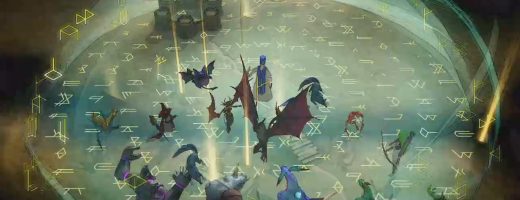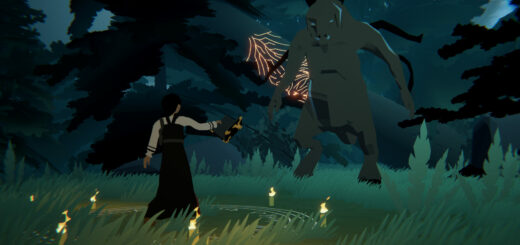Editorial à la Carte: Sushi Striker
Of all the genres across all the forms of media, the modern RPG is strange in that it is the most difficult to properly define. If you pose the question of what makes an RPG to any given forum of fans, you’re liable to receive six different claims from five different people and at least one long argument about why everyone else is mistaken. The funny thing is that, even in disagreement, there will be some consensus over what features and elements to include. Often the argument stems from which games count under whose definition, either because of or in spite of those common traits.
This is why I usually refer to it as the RPGestalt, though I’ve yet to get anyone else to use the term with me. The individual parts aren’t as important as the way they come together or the manner in which they are presented.
And so I am reminded of sushi. Everyone has a general concept of sushi: fish on rice. How accurate that image is varies by experience, nationality, and regional tastes, but the reality is more nuanced than many realize. Taking the ingredients commonly associated with sushi — raw fish, rice, dry seaweed, soy sauce, maybe wasabi — we can make many different dishes.
Maguro-nigiri, tekka-maki, tekka-don, maguro onigiri, ahi poké with rice… Going down a checklist of ingredients, these five foodstuffs would appear to be highly similar, while the reality is that they are anything but. Although they are all scrumptious, only two of them are sushi. In this modern age of gaming, where so-called RPG elements like stats and experience points have found a home across many disparate genres, the sushi metaphor is more apt than ever.
So let’s go to where metaphor meets reality and talk about Sushi Striker: The Way of Sushido for 3DS and Switch. On paper, Sushi Striker ticks all the boxes on the RPG checklist: central plot, engaging combat, experience-based leveling, cute animal companions, as well as items and equipment to assist the player. It would seem to be a fit to the definition of RPG and yet, after spending part of the summer on its campaign mode, I would have to disagree. It’s a fun, frenetic action-puzzle game, and I enjoyed it a lot, but it was not an RPG where it counted most, in the heart.
Why was that, when it possesses so many of the requisite ingredients? That was a question that I had to ponder for many months. Much of it, I have come to realize, lies in how Sushi Striker defines its core element and then builds everything around it.
Sushi is the theme, and sushi fights are the pillar upon which everything depends. Heroic Strikers make pacts with the cute Sushi Sprites who summon infinite conveyor belts of sushi plates from the great beyond. The player tries to link as many plates of the same color as possible, piling them high before sending them to slam against their opponent’s defenses. The varieties and point values of sushi increase as the Sushi Sprites gain levels, and there are tricks involving specialty plates and sprite powers, but the general format does not change from beginning to end. Items feel more like an afterthought, occasionally useful but rarely critical to a battle’s strategy.
The plot is pure shonen manga fare, and gloriously so. There’s the evil empire, the plucky resistance with a sketchy leader, four great generals with hordes of sushi-slinging mooks, but very little is done outside of the overarching theme of “Give us sushi or give us death!” The general progression of the plot sees the player moving ever forward and onward to the next map point, getting a short scene to introduce the next opponent and then going straight to the action. No side-tracking, no extraneous story content, and every map point can be revisited for the exact same scene and battle to challenge for a better score. While I have played puzzle RPGs where the plot was inextricably bound to the battle system — among them Puzzle & Dragons and Monster Strike for the 3DS, or Might & Magic: Clash of Heroes and Dinosaur King for the DS — those games had at least the pretense of a plot happening outside the bounds of their puzzle combat. The best comparison to Sushi Striker would be the campaign mode of the later Puyo Puyo games, which no one would ever mistake for an RPG.
Therein lies the crux of the matter. Sushi Striker is a fun puzzle game with a campaign mode precisely because that is what its designers were aiming to create. The fact that it has many of the core design elements associated with RPGs does not change the other fact: that the game was built to be a stage-based competitive puzzler. It has the parts, but the composition is different, in much the same way that ahi poké is chopped tuna on rice, and yet is not sushi. One can easily imagine what changes, what tweaks could be done to bring this game more effectively under the umbrella of the RPGestalt, but those were not things which the designers felt were necessary for their vision of the final product.
And so, perhaps, we have the most basic criterion of all: Was the game presented as an RPG? If the answer is “No,” then half the argument is already done. If the game’s own creators did not see it that way, then anyone arguing for its inclusion has that much more to argue. For me, Sushi Striker will always be a fun, casual way to waste some time in the evening, but it will never feel 100% an RPG to me. And that’s okay; it’s still a good game.













Recent Comments